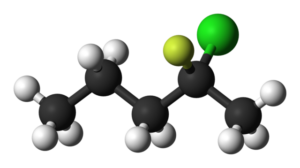Playlist
Show Playlist
Hide Playlist
Cahn—Ingold—Prelog Rules — Stereochemistry
-
Slides 04 Chemistry Basics Le Gresley.pdf
-
Download Lecture Overview
00:01 Right, okay. We talked earlier on in this lecture about alpha, levorotationary, dextrorotationary. 00:10 That is all very well and good. 00:12 There is even a very archaic L and D nomenclature that was used as well. 00:17 But the current IUPAC accepted nomenclature used to define stereochemistry within a molecule is known as the Cahn-Ingold-Prelog rules. 00:27 As you can see, we got an idealized molecule here. 00:32 It consists of a central carbon to which is attached four different things. 00:36 CH3, hydrogen, an OH group, and a bromine atom. 00:41 As you can probably instantly recognize, there are four different substituent groups on this carbon therefore it must be chiral. 00:49 But the process by which we assign under Cahn-Ingold-Prelog Rules, the designation of it as an enantiomer is by ranking first the attack substituents to the chiral center according to their atomic number. 01:06 That is the first thing we do. 01:07 In this system it’s relatively straight forward. 01:10 Bromine is a halogen, has the largest atomic mass. 01:14 Therefore, it must automatically take priority. 01:17 The second is an OH group. 01:20 Of course, the oxygen having an atomic mass of 16 is the next highest. 01:24 Finally, carbon with an atomic mass of 12. 01:28 As you can see we are able to easily assign orders of priority according to the atomic mass that we have on our substituent group. 01:38 Unlike other systems of nomenclature, if there is any similarity at any substituent you need to continue moving away from the stereogenic center, until such time as difference in atomic constituents is found. 01:58 Multiple bonds count as multiple substituents of the same atom and this will become important when we start looking at other functional groups. 02:09 But to give you a very simple example what that 0.3, means is that if for example you have a double bond, this actually counts as a carbon to which is bonded two CH3 groups. 02:23 Where it becomes important in these rules, which are effectively man-made to help us decide our chemistry, we need to consider the number of bonds. 02:33 What you then do, is you rotate the lowest priority group to the back. 02:40 Now, obviously, in a two dimensional environment such as that we are in, this is rather difficult to do but it is a test for you to ensure that you have been paying attention. 02:50 You need to visualize in your mind this tetrahedral structure, where the bond is dashed, imagine that is pushed backwards. 03:00 Where the bond is thick, imagine this is coming towards you. 03:05 Then try and picture this tetrahedral structure and rotate it on the bromine axis to move the hydrogen towards the back. 03:17 By moving the hydrogen towards the back, what we are effectively doing is bringing the bromine, the OH, and the CH3 group, round to the front and what we can then do is consider in what order of priority the atoms can be linked together, counting from one to two to three. 03:41 If we rotate that system around, all the way around, we see it is possible for us to count bromine, then OH, then CH3. 03:52 When we can count in order of priority, in a clockwise direction on the face of a tetrahedral molecule, we can assign it as R. 04:04 If on the other hand, we can count from one to two to three on the face of our tetrahedral molecule, which contains those three highest priority associated atoms and substituents or we can go in an anticlockwise direction, then it is otherwise known as S. 04:24 These have their origins in the term for Rectus or right and S, sinister. 04:32 The process is by using this said to assign the configuration to any chiral molecule that you will come across. 04:41 I have shown here a simple example. 04:45 If we rotate our bromine all the way around, so that we have our OH on the left hand side and the CH3 on the right hand side, you can see in the case of unknown chirality, we can assign it R or rectus. 04:59 What I would like you to do, for the next few minutes is to attempt to assign using Cahn-Ingle-Prelog Rules, the configuration of these enantiomers. 05:12 Identify the carbon center, assign the priority groups, and then determine whether or not, the order of priority one, two, or three is clockwise, rectus, or anticlockwise, sinister. 05:28 Next, what I would like you to do, is attempt to draw the structure of R2 bromobutane. 05:36 Based on your understanding, that there must be a chiral center in them.
About the Lecture
The lecture Cahn—Ingold—Prelog Rules — Stereochemistry by Adam Le Gresley, PhD is from the course Chemistry: Introduction.
Included Quiz Questions
Cahn-Ingold-Prelog rules are used to do which of the following?
- To assign the configuration of chiral molecules.
- To determine the molecular mass of chiral molecules.
- To determine the chemical behavior of a solution containing a chiral compound.
- To determine the molarity of a solution containing a chiral compound.
- To determine the normality of a solution containing a chiral compound.
According to Cahn-Ingold-Prelog rule, multiple bonds count as which of the following?
- Multiple substituents at the chiral atom.
- Single substituent at the chiral atom.
- No substitution at the chiral atom.
- Another chiral atom attached to the chiral atom.
- A substituent equivalent to a hydrogen atom attached to the chiral atom.
Customer reviews
5,0 of 5 stars
| 5 Stars |
|
5 |
| 4 Stars |
|
0 |
| 3 Stars |
|
0 |
| 2 Stars |
|
0 |
| 1 Star |
|
0 |




